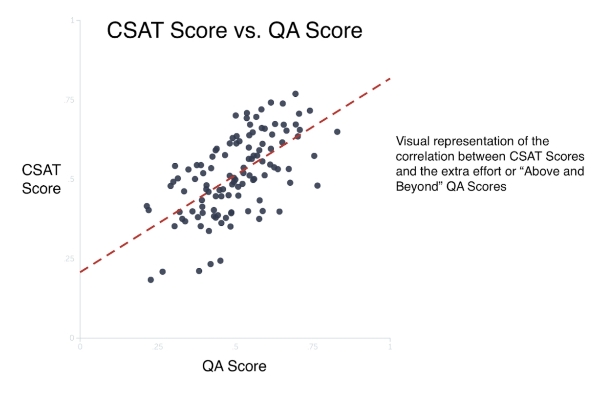Most contact centres measure their customer service using metrics that only tell part of the story. Measures such as NPS and CSAT are highly contextual, fraught with instrumentation difficulties and only relate some of your customers’ experience and success.
Customer engagement, by contrast, tells the objective tale of how willing your clients are to engage with your business anytime, and in any way.
First, what exactly is customer engagement?
Customer engagement is the set of ongoing interactions between your customers and your brand: specifically, it’s that set of interactions that your customers choose to have with your organisation. Those interactions are really specific to your business. You have to define what they are in context. But, the joy of customer engagement as a concept is that it’s measurable and you can influence it across the brand, in how your business behaves to its customer base.

High levels of customer engagement are critical to business success. Research from Gartner reveals that a customer who is fully engaged represents an average 23% premium in terms of share of wallet, profitability, revenue, and relationship growth compared with the average customer. That’s a staggering uplift.
And what is ‘quality assurance’?
In a customer service context, quality assurance is the process an organisation can use to ensure all those customer interactions with your customer service team meet a specified standard. That standard is set by the organisation, and usually concentrates on tone, accuracy and compliance of the service provided.
Your customer service provision forms a significant, or even majority, portion of the interactions your customers initiate with your brand.
Ensuring an excellent and consistent quality of customer support maximises the influence your service department has over ongoing customer engagement levels. Quality assurance, as a practice, pays dividends in engagement.
Here are five ways measuring quality increases your customer engagement:
1. High QA scores correlate closely with high CSAT scores
Your organisation might still value and promote its business on the basis of outstanding CSAT results. When significant correlation has already been shown between a high QA score card and similar success on a CSAT scale, then it makes sound business sense to invest in a QA process to support that.

Positive correlation between high CSAT and high QA. Support Driven.
Although CSAT may be a necessary foundation for building strong customer relationships; by itself, it’s a relatively poor indicator of future customer behaviour. But, the good news is, as outlined in corresponding research by Gallup, “emotionally satisfied” customers have correspondingly high levels of engagement with a brand, and deliver enhanced value to a company.
By contrast, “rationally satisfied” customers – who might still claim in a survey to be satisfied with their experience, have low engagement levels and generally behave no differently than customers who are dissatisfied. Which brings us to an extremely important second point…
2. Customers who are dissatisfied generally churn with no notice
Dissatisfied customers won’t engage with your company, either through future purchases, or even through surveys.
Only 1 in 26 customers bother to complain while the rest churn (leave your business) without giving your organisation any notice. This lack of communication – the absence of feedback in the form of a positive survey – should not be understood to be equivalent to a satisfactory customer experience.
These customers are indifferent, and, by extension, they are unengaged. This missing feedback gives you no information at all about the quality of experience. Implementing a solid QA process maximises your chance of providing a positive service, even in the absence of direct customer feedback.
3. Churn due to poor service is often preventable
Customers who leave a business due to poor service could have been retained before the poor experience even happened. In fact, it’s been shown that 85% of customer churn due to poor service is preventable.
Companies with QA score cards that focus on the customer perspective (rather than business goals directly) ensure that their clients stay with them.
Forget checklist items that seem important, like “Agent used customer name three times”, and focus on targets that your customers will actually care about, like responsiveness to needs, and accuracy.

4. QA minimises misinformation
An almost identical percentage of customers (84%) state they are frustrated when an agent doesn’t have the right information. You can build a QA process that ensures more than just tone of response.
Your QA rubric should ensure appropriate and accurate information, correct reference to the relevant materials, and corporate or industry standards compliance.
5. Customers are willing to pay more for a great experience
It should come as no surprise that 55% of consumers are willing to pay more for a guaranteed good experience.
The key word here is ‘guaranteed’: customers are no longer satisfied with just being promised a good experience, and being left to complain about any shortcomings after the fact. Customers would rather just have assurance of quality ahead of time, and, importantly, are willing to pay for it.
This isn’t an invitation to implement a premium service tier just to charge your customers more, but rather a call to arms to empower all your agents to deliver a great experience. Customers who consistently get a guaranteed good experience will keep coming back for more.

In summary… Great QA boosts customer engagement
A well-structured and considered QA process gives your agents power to deliver all the things your customers need. Even more, it practically guarantees that service delivery. High levels of service quality out the gate, before you even ask your customers what they thought, ensures quality conversations and accurate information.
Your customers will learn to trust your service team. And with that trust, comes high engagement, repeat business and your organisation’s reputation.
Additional Information
 Charlotte Ward has a tech support career spanning 25 years, on the front line and in leadership, for blue-chips to startups. Now, she heads up Join The Dots Consulting, building exceptional customer care and support experiences that customers will want to tell their friends about.
Charlotte Ward has a tech support career spanning 25 years, on the front line and in leadership, for blue-chips to startups. Now, she heads up Join The Dots Consulting, building exceptional customer care and support experiences that customers will want to tell their friends about.
Looking to introduce QA? Check out our guide, Quality Assurance: Getting started with QA by Clicking Here
For additional information on EvaluAgent visit their Website or view their Company Profile




